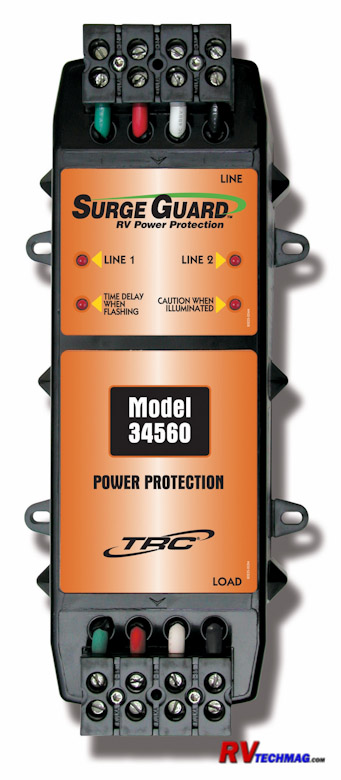Outfitting Your New RV
Adding all Those Must-Have Items and Handy Accessories
Article Date: August, 2014
Article by Mark Quasius
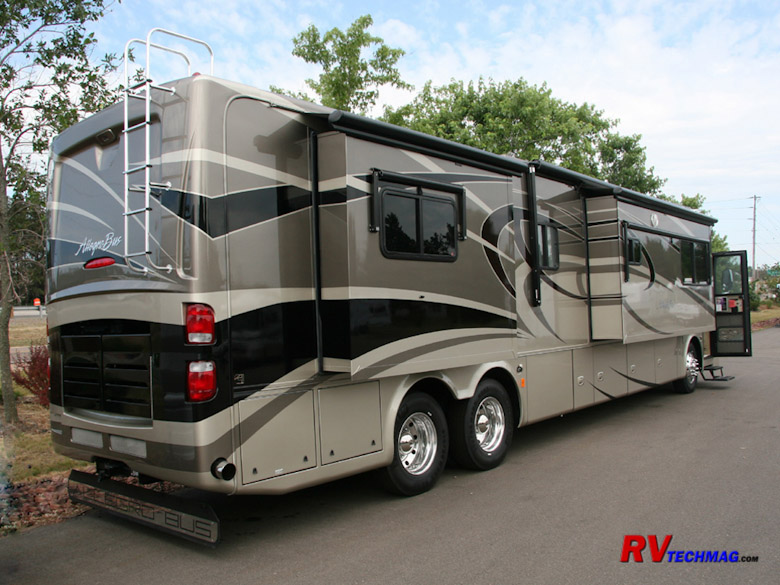
Congratulations! You've finally made the move and purchased your first motorhome. You've researched brands and models,
kicked some tires, spent countless hours on the Internet checking out reviews and comments from user forums and you've made your choice. You've
spec'd everything out and gotten the motorhome that will best suit your needs. It's equipped with every option that you might possibly need and
now you're ready to go RVing, right? Wrong! Your RV is much like a new home. Without furnishings and "other stuff" it's just an empty shell. So,
off you go, buying some extra dishes, cookware, silverware and other things necessary for cooking meals in your new galley. Also, you'll need
bedding, pillows and the like so that you can sleep in the RV. Then there's that extra leash for Fido, the dedicated road atlas that stays in the
RV, and the list goes on and on.
Just when you think you have the basics covered you realize there may be a few other things that you missed. An RV is
different than a sticks and bricks house and there are those RV specific items that you never considered. After all, your local RV dealership
and the nearby Camping World store is loaded with all sorts of stuff that you will probably need, right? Well, that answer can be yes or no,
depending on the item. RV accessories come in different categories. One is the "must have" category, which represents the things you absolutely
have to have in order to RV in a safe and trouble free manner. The next category is what I call the "handy accessory" category. These are things
that you can live without but they really make RVing better and easier. Just how many of these items you need will depend on just what you want
from an RV and how much you want to spend on it. The last category is the "fluff" category. This is the stuff that no one really needs. Much of
it is trinkets that you waste your money on with no real return on investment. Think of led under-bed lighting or a Raccoon tail hanging from an
antenna as a good example of this. Then again, if you really like Raccoon tails, go for it. Everyone's idea of a custom touch is different.
In this article I'll try to outline my ideas of the things that you are going to need when you first set up your RV as
well as the optional items that can be handy. I'll skip the final "fluff" category and leave that to your own personal taste. I'll also skip
the personal items such as dishes, bedding, etc. You're the best judge of that so I'll just keep to the RV specific accessories.
The Essentials
Just when you think you have purchased a brand new motorhome and it's all complete you'll quickly find out it's not complete
at all. It undoubtedly came with a power cord and a cheap sewer hose but that's about it. You'll need to be able to provide power and water to the
RV as well as a way to remove waste. Then there's the safety issues - both while driving and when parking. This following group will cover the
basic items that are essential to proper and safe operation of your motorhome.
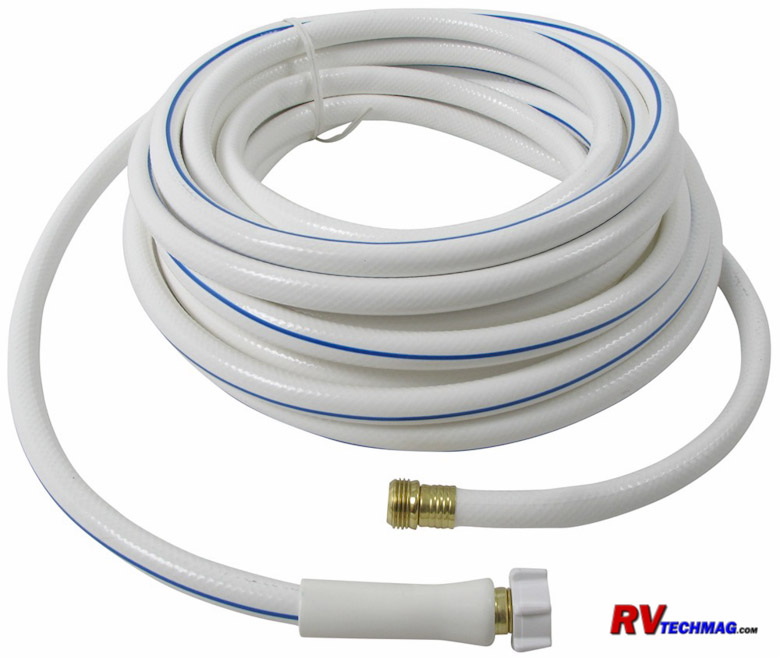
RV Water Hose
RV water hose is the first thing you'll need. RV water hose is designed for drinking water and is constructed of FDA approved
materials and generally comes with a white jacketed cover. Your run of the mill garden hose is not safe to use as drinking water hose so be sure to
have a couple of these along. If one of these blows you'll want to have a spare so that you don't have to scramble looking for a new hose after the
camp store has closed for the evening. Ideally you'll want a 25' length and a 50' length so that you will have a choice, depending on how far away
the water spigot is. You can use two 25' lengths to give you 50' but if one hose blows you be short if you needed more than 25' of hose.
Due to sanitary concerns you never want to use these hoses for anything else. Keep a regular garden hose to use for washing
the RV or for connecting to a black holding tank flushing attachment. That will keep dangerous bacteria away from your fresh water hose fittings. I
carry a small spray bottle with a Chlorine bleach water mixture in my water service bay. I always spray the threads on the campground spigot before
connecting my hose to the faucet because you never know what was the last thing to touch the spigot. If you plan on using two hoses at the same time
you can buy a small Y adaptor with petcocks to attach to the campground spigot.

Water Filters
Campground water isn't always the best in the world. Rust, sediment, as well as bacteria can be pushed through your nice clean
fresh water hose and into your RV's fresh water tank and plumbing system. At the very least it can make for some bad tasting water while it can also
add a ton of unwanted sediment to your fresh water tank. To prevent this you'll need a water filter.
Water filters come in stationary models that can be mounted in your basement water bay or they may be in-line filters that are
placed into your fresh water hose. If you use the in-line filters be sure to buy an extra short white water hose so that you don't have to hang the
filter on the water spigot, which is probably too low to the ground anyway. In-line filters are generally smaller so you'll be replacing them more
frequently but they have the benefit of convenience. Mounted water filters have longer life and can pass more water volume due to their greater
filtration area and also are available in different compositions but they do require a dedicated space to mount them in your water service bay. You
can keep them portable like the in-line filters and just set them in a bucket to keep them from tipping if you want but generally it's more convenient
to just mount them and forget about them.
Water filters vary in the ability to flow enough water and in the ability to adequately filter the water. It's hard to trap
every last spec of sediment with a fine filter and still expect good water flow. You tend to get one or the other. I have personally found the
Hydro Life HL-200 Canister System
to be the best. It comes with garden hose fittings so it can be portable but they can easily be removed and the filter can be direct plumbed into the
water service bay's plumbing lines. It is available with the basic
C2471 Carbon Cartridge but
the best choice is the
C2063 Bacteriostatic Cartridge which filters out most any kind of micro-organisms in addition to the taste and sediment features. The Hydro Life
system has excellent water flow rates for a filter that does so much filtration and is highly recommended by many RVers. Note that these elements may
fit a number of other brand filter housing. However not all of those brands will have adequate ports in the filter head to pass through the higher
water flow rate that the HL-200 has.
|
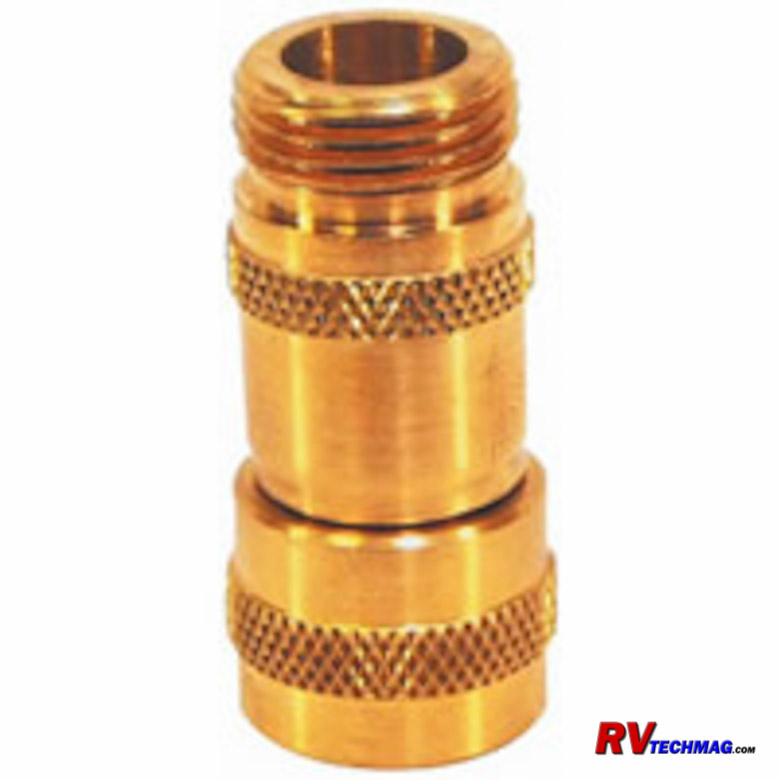
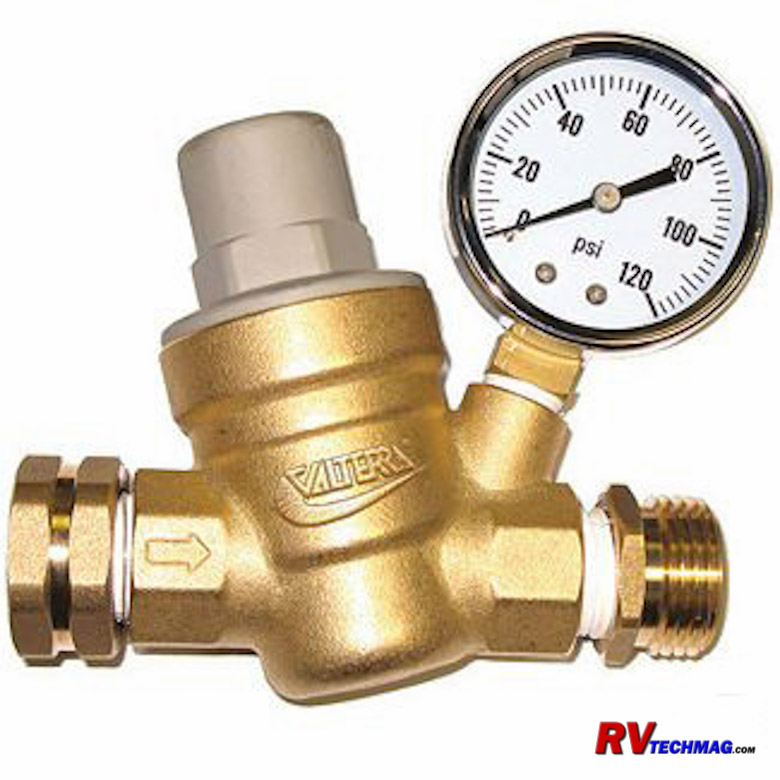
Water Pressure Regulators
|
RV water systems are pressure tested at the manufacturer to hold in excess of 100 PSI without leaking. That doesn't mean that
you want to continue testing your motorhome's water system constantly like that unless you like pushing your luck. The first time you open a faucet
at 100 PSI and have water splashing out of the sink you'll quickly realize why you need a water pressure regulator. The majority of campgrounds don't
have any issue with excessive water pressure. In fact, most have a problem with not enough water. But there are a number of them that crank their
water pressure very high so that they can deliver that water to every campsite - especially those on the far end of the park. For this reason you
need you have a water pressure regulator so that you can prevent the water pressure from reaching excessive levels. Standard city water pressure is
65 PSI so that's where you'll want to set your regulator at. There are two styles of regulators. The small in-line pill type, as shown on the left,
is really not a true pressure regulator. It's a flow restrictor designed to reduce pressure by restricting the flow. You don't want to use one of
these because they will restrict the flow of water to your coach and it'll take longer to fill sinks, take showers, etc. Purchase a good adjustable
pressure regulator, like the one on the right, that also has a gauge. That way you'll know just what the regulator is set at. If the water pressure
is mildly high you can place the regulator inside your water service bay if you like. But, keep in mind that your fresh water hose is probably rated
with a 100 PSI burst strength so if the pressure at the spigot is excessively high you should place the regulator on the spigot to protect your
fresh water hose as well.
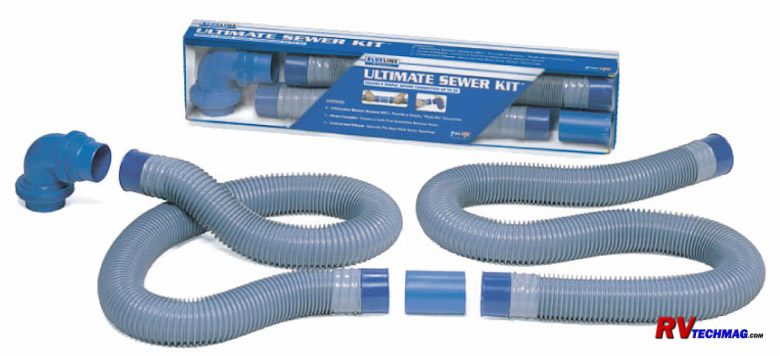
Sewer Hose Kit
Okay, now that we have gotten everything taken care of as far as getting water into the motorhome it's time to think about how
to get it out. Eventually your holding tanks are going to fill up and you are going to have to deal with the pleasant task of dumping them. For this
you will need a sewer hose.
Whether you boondock or utilize full hookups, the end result is the same. Sooner or later you are going to have to dump.
Dumping can be a messy job if done incorrectly but it's not all that bad if done using the proper equipment and procedures. For that you are going
to need a good sewer hose kit. Sewer hoses are made up of 3" diameter corrugated plastic material that is reinforced with a metal wire. The hoses
generally come in 10' or 20' lengths when extended. A 20' sewer hose may only be 3' long when compressed but unless you have some kind of tubular
container to put the hose into that's not going to happen because they bounce back and spread out, taking up more room in the storage tray. If the
hose is very long it will lay like a snake in a large S curve and be very hard to stuff into the bay neatly. Many times a 10' hose is adequate to
reach the sewer and the shorter run is much easier to handle. Yet there's times when a 10' hose won't reach. My solution is to not buy a 10' and
20' hose. Instead I have three 10' hoses. Two of them have male and female bayonet connectors on them so they can be used as extension hoses while
the main hose has the right angle head on it to go into the sewer. And yes, there were a few times where I needed 30' of hose. They can get damaged
easily so having three 10' hoses gives me a spare under most situations. Most right angle heads come with threaded adaptors that slip over the nozzle.
But there are times when you will encounter a plain open pipe and the threads won't work for you. Silicone rubber donuts that slide over the nozzle are
available for these situations in order to hold the nozzle into the sewer pipe. You will want to have one of these as well or else you'll be cleaning
up some ugly messes in the future. This is one area not to cut costs. The cheapest sewer hose is thin and will tear easily. Heavier duty hoses are
usually brown in color and the best are the super duty hoses which are generally gray in color. Advertising plays a role here so colors can change and
so can advertising titles, such as heavy duty, super, ultimate, etc. When purchasing sewer hose pay close attention to the thickness of the hose wall,
rated in mils. Thicker is better. I have had good results with Camco's Super Duty 18 mil hose although Valtera's 21 mil Triple Wrap hose also looks
promising.
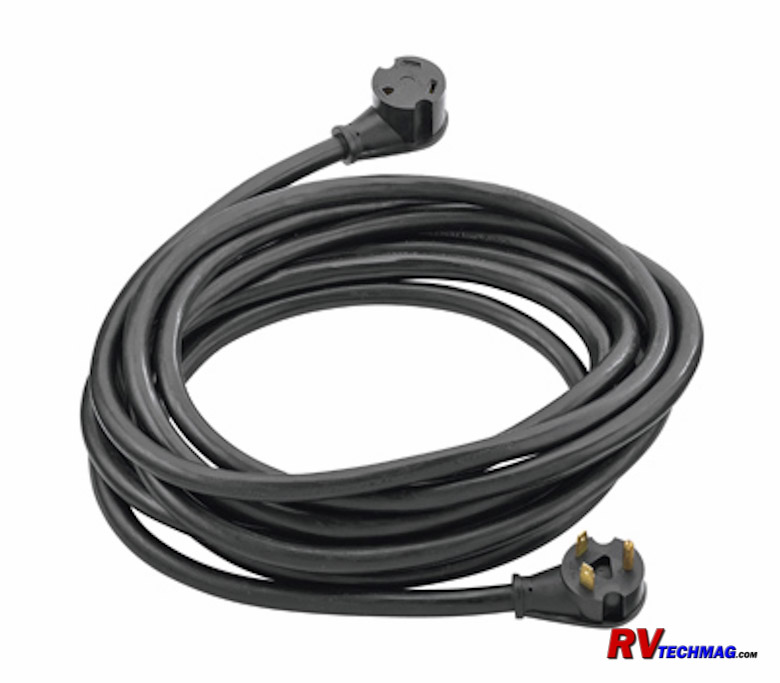
Power Cord Extension
Your motorhome came with a power cord. Most RVs with a 30 amp service have a 50' power cord while those with a 50 amp service
will have a 30' cord due to the larger diameter and heavier weight of the cord. Sometimes you'll find that you won't be able to reach your power
pedestal with your cord so an extension cord is required. Both 50 amp and 30 amp extension cords are available in various lengths from any RV dealer
or camping store.

30 Amp to 50 Amp Dogbone Adaptor
If you have a 50 amp service in your motorhome you'll be able to plug into any 50 amp RV outlet and run your coach. However,
not all campgrounds have upgraded to 50 amp service. Some of the older ones are still limited to 30 amp service. A 50 amp cord has 4 prongs to supply
power to both legs of your 50 amp breaker panel. A 30 amp outlet only has one single leg fed through a 3 prong outlet so you will not be able to plug
your 50' cord into a 30 amp receptacle. To overcome this you will need a short 2' long adaptor cord, commonly referred to as a dogbone. This adaptor
will have a 3 prong plug that plugs into a 30 amp campground pedestal on one end. The other end will have a 4 prong receptacle that your RV's 50 amp
cord will plug into. The dogbone adaptor also feeds the single hot pole from the 30 amp to both hot poles on the 50 amp side so that both halves of
your breaker panel will be fed power.
Surge Protectors
Motorhomes come with some pretty sophisticated (and sensitive) electrical components. If you receive a voltage spike or power
surge, you can sustain some serious damage to your RV. Likewise, low or high voltage can quickly make toast out of air conditioner units, televisions
and microwave ovens. To protect your RV against brownouts, low voltage, high voltage, lightning hits, surges, and voltage spikes you will need to add
a surge protector. A quality surge protector will kill power to your RV if the incoming voltage gets out of tolerance as well as protect against
transient surges and spikes. Two of the most popular brands are SurgeGuard
and Progressive Industries. Various levels of capability are offered but be sure that you get more than just surge protection. Low voltage at
campground pedestals is a common occurrence and is very damaging to your RV because as voltage drops, the amperage goes up. This overheats motor
windings and electronics and can cause some expensive repair bills. Be sure to get a unit that also has low voltage cutout capability. These units
can be permanently mounted inside the RV or they can be portable and hang on the campground pedestal. If you have the room to permanently mount it I
would suggest doing that. It'll keep it secure from the weather as well as theft and it will be automatic so you won't have to set it up and take it
down every time you arrive at or leave from your campsite. The most popular model, and the one that I chose, is the
Progressive Industries EMS-HW50C, which offers an easy to read LED
remote display that can be mounted anywhere and provides surge and power protection second to none. Regardless of which model you prefer, RVing
without a good surge protector is much like driving without insurance. At some time down the road you will incur some serious repair costs due to
low voltage or damage from a power surge. This unit is cheap insurance against that.
|
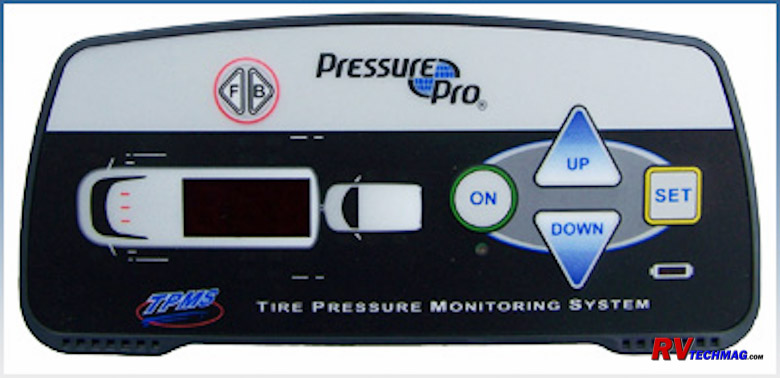
|
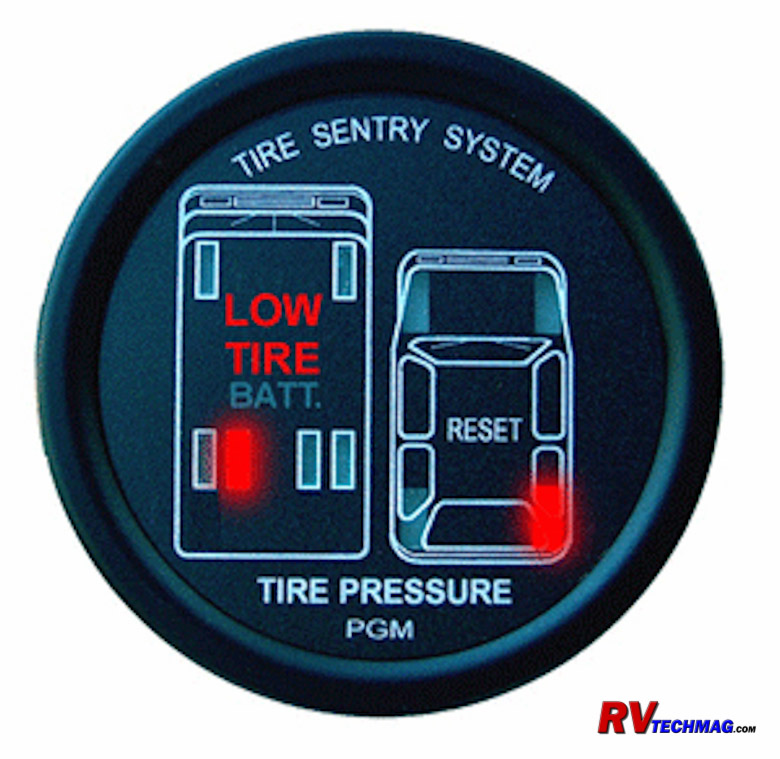
|
|
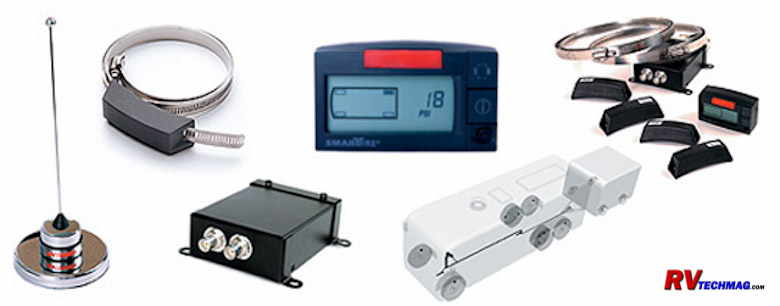
Tire Pressure Monitoring Systems
|
Tires are the single most important part of your RV. Without tires your RV is just a structure that can't go anywhere. When
driving down the road your tires provide control over the direction you are headed and the ability to stop when needed. If a tire should fail and
blowout while driving you will no longer have that control and you may be in for a wild ride that could have potential damage to the RV or even the
risk of death to it's occupants. Tires generally need to be replaced due to either age or wear rather than from high mileage. The majority of tire
failures occur either due to running them too many years beyond their service life or from low pressure.
Tires will degrade if they overheat and ply separations and sidewall failures can occur. Every tire requires a certain amount
of air pressure to care a given amount of weight. If the tire is run at a lower pressure the tire will get hot. If this continues you run the risk of
a catastrophic tire failure. For this reason it's important to maintain adequate tire pressures in your RV's tires at all times. Tire manufacturers
such as Goodyear and Michelin provide online tire pressure charts that will show you how much air you need to run in your tires. You will also need
to have your RV weighed to give you the accurate weights at each axle in order to determine your minimum air pressure.
It's easy enough to check your tires with a tire pressure gauge each morning before you break camp. However, what happens if
you pick up a slow leak from a nail while driving? That tire will slowly lose pressure and build up heat. You won't notice that while driving until
it gets serious and by that time it'll be too late and you may have already destroyed the tire and who knows what else should it fail. For that
reason an onboard tire pressure monitoring system (TPMS) is a "must have" safety feature. Units are also available that will monitor the towed
vehicle from the RV. If your toad tire went down you wouldn't feel it in the RV and there are many instances where toad tires have disintegrated
and caused major damage to the toad. A multi-unit TPMS will give you adequate warning so that you can pull over and deal with the situation before
things get out of hand.
TPMS sensors can be mounted internally within the tire or externally on the valve stem. There are many models available and
the TPMS market is developing rapidly so we won't try to go into the various models here. The major players in this market at the moment are
Tire Sentry, Pressure Pro, TST and Tire SafeGuard. For more information on selecting a TPMS system be sure to inquire in the various user forums,
such as the TiffinRVNetwork or iRV2
to see which products other RVers are having good success with.
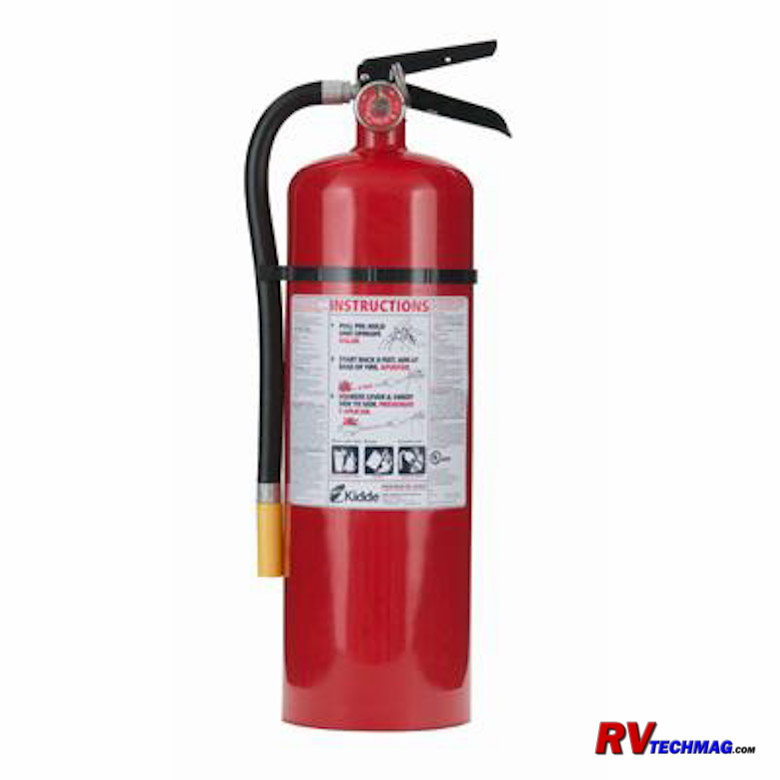
Fire Extinguisher
RVs come equipped with a fire extinguisher. However, they are the minimum size required by law and really won't be of much
value should you ever need to use it. Your best bet is to replace it with a larger unit that has more capacity. Consider looking at other types of
extinguishers as well. The Fire Safety article at This Link can be helpful in deciding which type of extinguisher
is best for you.
Handy Accessories
Now that we've covered the essential items in the previous section it's time to go to the "'Handy Accessories" section. You
don't absolutely have to have the items in this group in order to go RVing, but many RVers choose to pick up at last some of them, if not most of
them. These are the items that will help smooth out your RV experience by minimizing work and just plain making life easier for you. How much of
this stuff you will want to get depends on what you style of RVing is like, how much you value these add-ons, and how much you are willing to spend
for them.
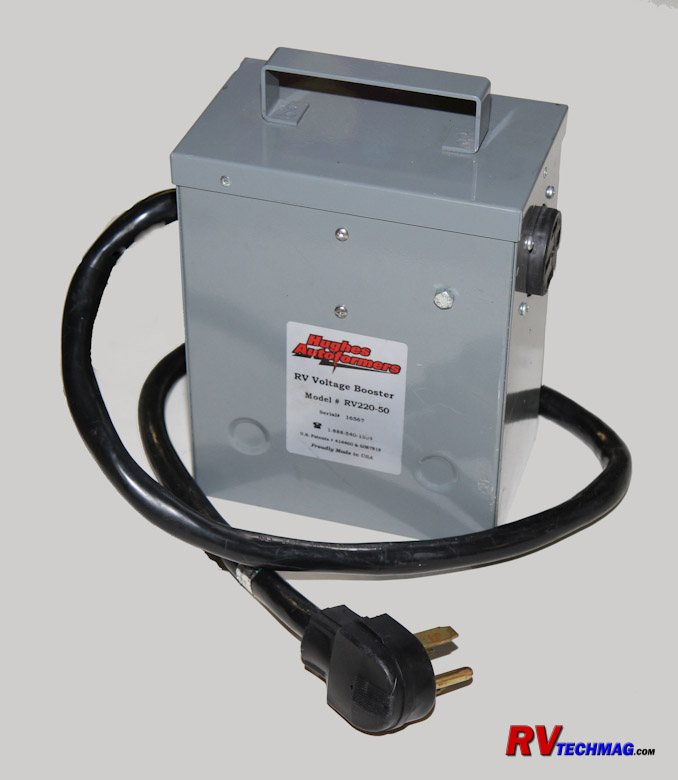
Hughes Autoformer
While a surge protector is a mandatory accessory, an Autoformer is optional. A surge protector while protect the coach by
shutting off any incoming shore power should the voltage be out of tolerance. However, should you experience low voltage at a campsite you'll now
be disconnected from shore power so your coach will now suffer loss of 120 volt AC power. An Autoformer will boost the incoming voltage so that you
can continue to operate your electrical systems. It will typically boost voltage by 10% so if your incoming voltage is way too low, you'll still
have a dead coach. But, generally the voltage is low enough to trip the surge protector but not so low that the Autoformer can't boost it to a level
that your surge protector feels is safe to pass. If you have a residential refrigerator or rely heavily on your AC electrical system and frequent
campgrounds where low voltage issues crop up every now and then, an Autoformer might be a good investment for you. Autoformers are typically made by
Hughes Autoformer or
Franks Electronics.
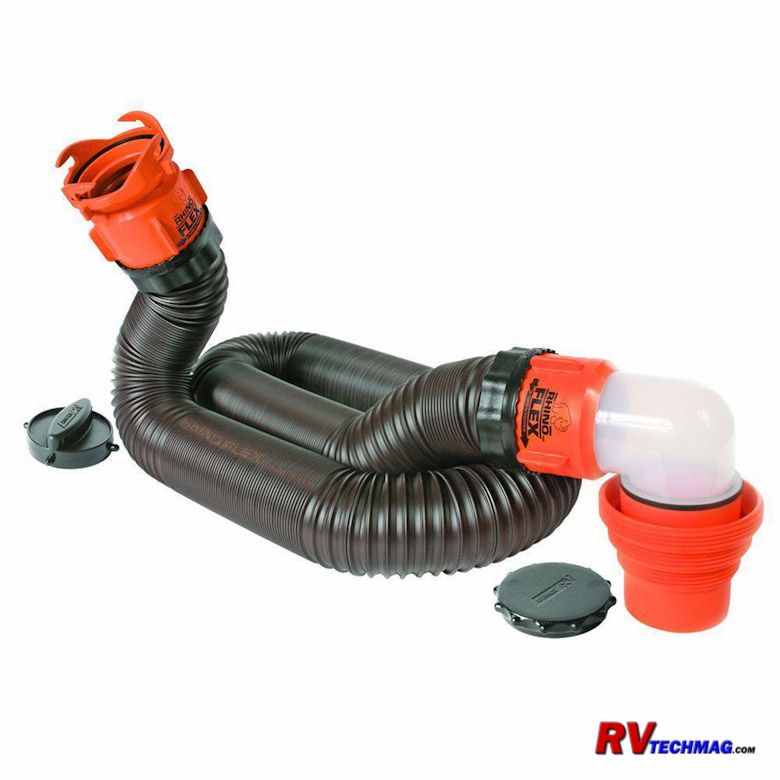
Rhino Sewer Hose Kit
RV sewer hose are not long lasting items. They are made of plastic and the constant flexing tends to create cracks after a
while. They also suffer badly in cold weather. Camco's Rhino Sewer Hose is one popular upgrade to standard sewer hoses. It uses heavy gauge hose that
stays rigid and formed to the way you have laid it, promoting better drainage and greater resistance to pinholes.
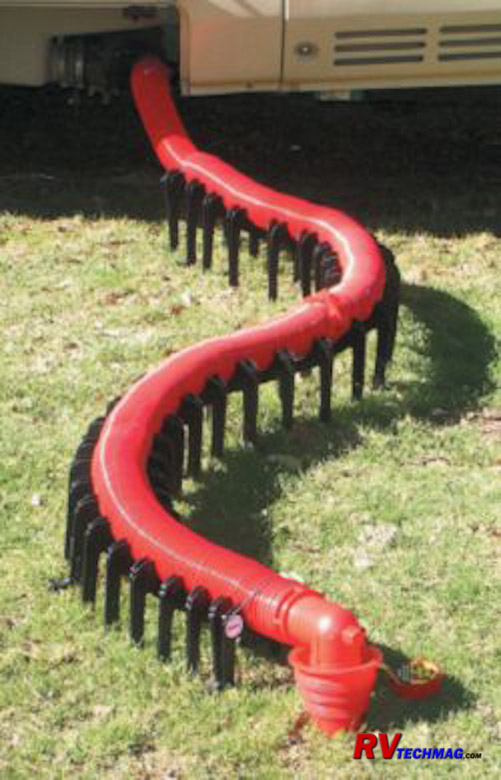
Sewer Hose Standoffs
Sewer hose standoffs are another popular accessory. Sewer hoses generally need to drop down after exiting the RV. They then
need to rise up to enter the sewer connection. A set of standoffs can form a trestle that the sewer hose can lay on, providing good pitch for better
drainage.
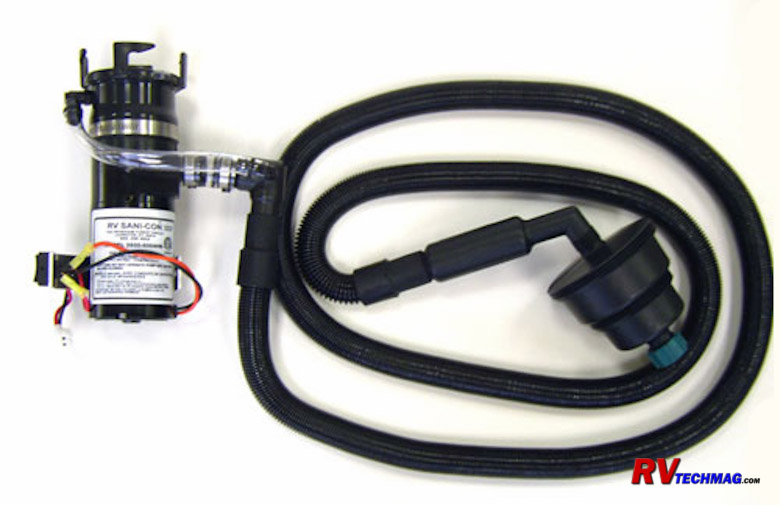
RV Sanicon System
A macerator system, similar to the RV Sanicon system will allow you
to ditch your 3" diameter sewer hose and replace it with a smaller hose and macerator pump. The pump grinds up the waste and is capable of pumping long
distance, and uphill. When finished you just screw a cap on the end of the hose and coil it up in the bay. No rinsing of the hose is necessary and the
smaller diameter makes it much easier to store.
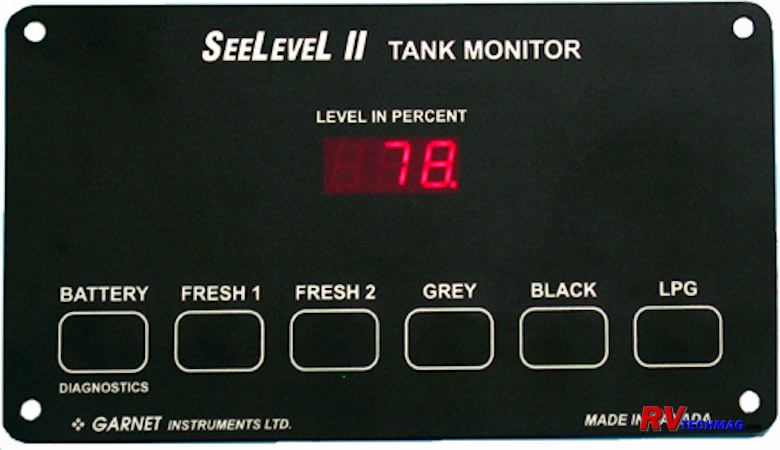
SeeLevel Digital Tank Monitoring System
Getting an accurate reading on holding tank levels is a problem that has plagued RV owners for many years. Most OEM systems
utilize internal sensors at 1/3 intervals. As soon as the water level in the tank reaches that sensor, an LED will light up indicating the level has
reached that point. However, these sensors are prone to errors. Black and gray tank sensors can get plugged with debris that renders them useless.
Even when they are functioning as designed, they still only give readouts to the nearest third. You may have a gray tank that is showing 1/3rd full
but in reality is just beneath the 2/3 sensor and will overflow once you begin that nice long shower.
To remedy this system you can add a SeeLevel tank sensor system. The SeeLevel system utilizes external sensors that cannot
foul. They are self-adhesive strips that stick to the outside of your holding tanks and have the ability to determine your tank levels by comparing
the density levels within the tank. This means that they cannot get fouled. An additional benefit is that they report tank levels in 2% increments
so if your tank is just beneath the 2/3 level the display will indicate something like 62% rather than illuminate a simple LED at the 1/3 position.
Various display panel combinations are available to fit your specific needs. SeeLevel systems can be purchased at RV Upgrades or directly from
Garnet Industries, manufacturer of SeeLevel products.
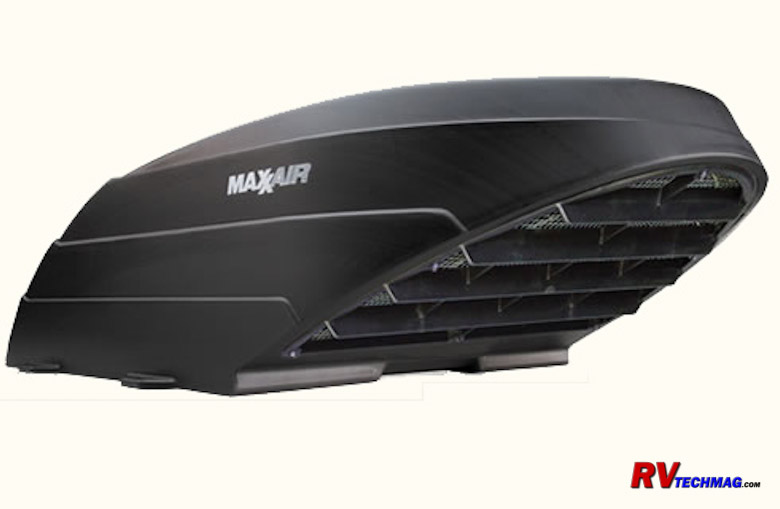
Fan/Mate Vent Cover
All RVs come with roof mounted ventilation fans. The most popular of these is the
Fantastic Vent Fan, which has a hinged lid that can be raised manually or electrically, depending on the model. However, for best operation a hooded cover is
essential so that the vent lid can be left open in windy conditions or when raining. The
MaxxAir Fan/Mate is the perfect companion for your Fantastic vent fans. The lids may also be left open to vent the coach while driving at highway speeds.
|
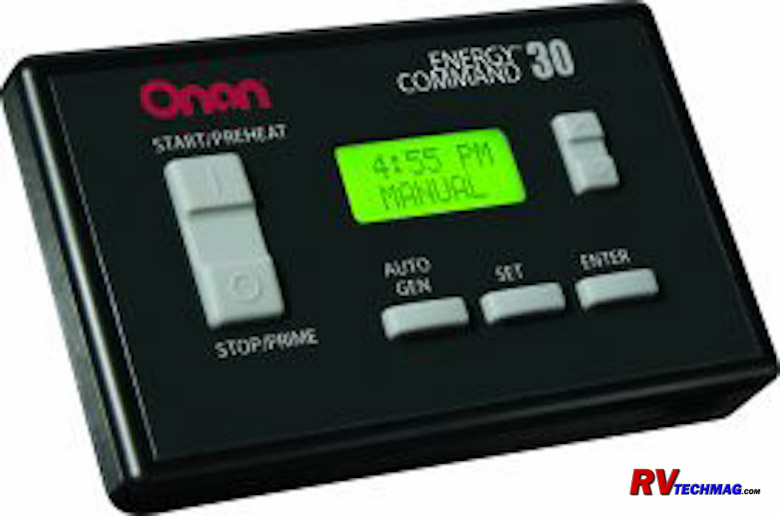
|
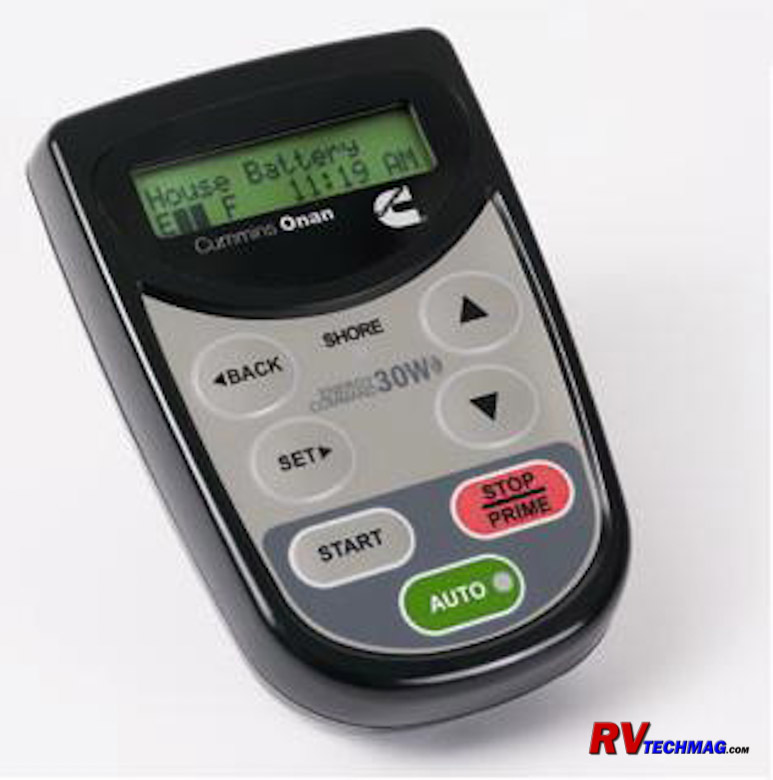
|
|
Automatic Generator Start Modules
|
Automatic Generator Start modules will automatically start your generator when you are away. They can be set to monitor low
battery voltage to enable recharging as well as monitoring your thermostat to kick in the generator to power your air conditioning should the
temperature in the coach begin to rise. Many of these modules are made by the various inverter manufacturers such as
Xantrex or Magnum but some of the
best models are available from Onan as well. They can
prevent your batteries from going dead or your pets from overheating while you are away.
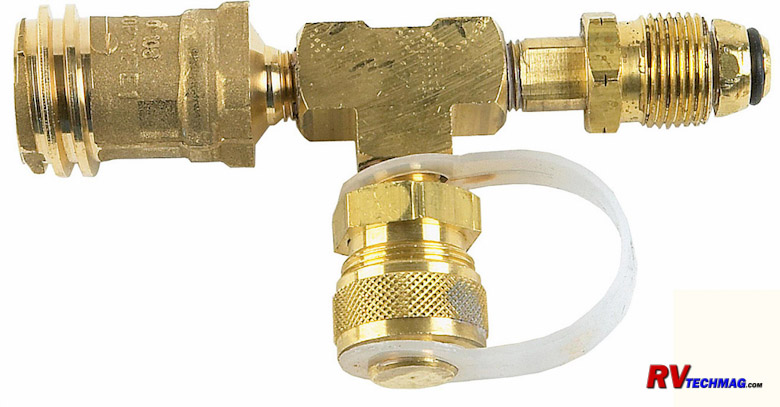
Extend-A-Tee
Your motorhome most likely has a large LP tank. Most portable grills are designed to work with disposable propane bottles.
Adding an Extend-a-Tee fitting to your LP tank will allow you to connect your grill to your RV's LP tank using a hose so that you don't have to deal
with the hassle and costs of the disposable propane bottles. Mr. Heater makes a number of models that are available. Some models feature propane
bottle threads to run your grill while some models also come with a thread designed to add a portable LP tank to help provide additional propane
to your RV without the need to move it to refill the on-board tank during long stays.
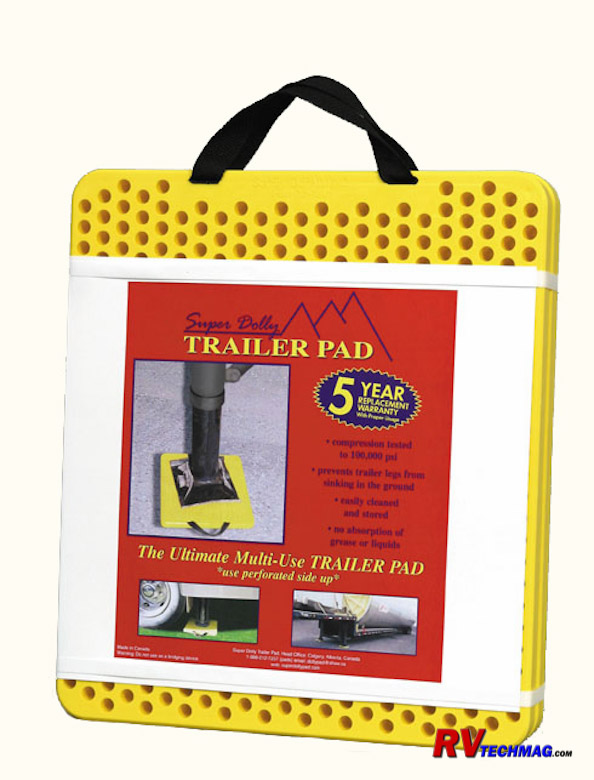
Jack Pads
Your motorhome has a set of leveling jacks to level and support the coach when at your RV site. When the ground is soft
these jacks will sink in unless you can distribute the weight of your RV over a larger area. Some RVers do this by placing wooden boards beneath
the jacks while some prefer to buy more durable jack pads. These pads are popular and can be found at most RV dealers or RV accessory stores.
Summary
Hopefully, I've given you some ideas as to what you will need to help outfit your RV. These items cover the basic necessities
as well as the most popular accessories. Some of these can be purchased directly from the manufacturer while some need to be purchased through retail
outlets. Your first place to check is your local RV dealer. Most RV dealers carry a decent line of accessories and it's in your best interest to
support them whenever possible. In cases where you do not have a decent RV dealer in your area you can always shop at the large
Camping World stores or go online. My personal choice of online RV store is
RV Upgrades. Outfitting your RV with the proper accessories will minimize the operational
tasks and help you enjoy it to the fullest.
Return to Home Page
If you enjoyed this article be sure to recommend RVtechMag.com to your friends, like us on Facebook or Twitter
or subscribe to our RSS feed.



|










